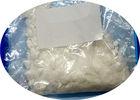Inorganic Chemicals
Testosterone Steroid Fluoxymesterone CAS 76-43-7 Breast Cancer Steroids
nutrition@chembj.com
Description
?
Testosterone Steroid Fluoxymesterone CAS 76-43-7 for Breast Cancer Usage
?
Product Name: Fluoxymesterone
Synonyms: 11-beta,17-beta-Dihydroxy-9-alpha-fluoro-17-alpha-methyl-4-androster-3-one;17-alpha-methyl-9-alpha-fluoro-11-beta-hydroxytesterone;17-alpha-Methyl-9-alpha-fluoro-11-beta-hydroxytestosterone;9-alpha-fluoro-11-beta,17-beta-dihydroxy-17-alpha-methyl-4-androstene-3-one;9alpha-Fluoro-11beta,17beta-dihydroxy-17alpha-methyl-4-androstene-3-one;9-alpha-fluoro-11-beta-hydroxy-17-methyltestosterone;9alpha-Fluoro-11beta-hydroxy-17-methyltestosterone;9-alpha-Fluoro-17-alpha-methyl-11-beta,17-dihydroxy-4-androsten-3-one
CAS: 76-43-7
MF: C20H29FO3
MW: 336.44
EINECS: 200-961-8
?
Fluoxymesterone?Pharmacology
1. Androgenic activity
Fluoxymesterone has a relatively high ratio of androgenic to anabolic activity similarly to testosterone.[citation needed] Like many 17α-alkylated AAS, it has relatively low affinity for the androgen receptor (AR). However, its actions are mediated by the AR, most likely due to its relatively long elimination half-life of approximately 9.2 hours.[4] It is approximately five times as potent as an AAS as testosterone.[5] Unlike testosterone, fluoxymesterone has a 100% oral bioavailability, as the methylation of the C17α position of fluoxymesterone inhibits hepatic metabolism by enzymatic oxidation of 17β-hydroxyl, allowing its absorption into the bloodstream for transport around the body.
?
2. 11β-HSD inhibitor
Fluoxymesterone has been found to act as a potent inhibitor of 11β-hydroxysteroid dehydrogenase type 2 (11β-HSD2) (IC50 = 60–630 nM), with a potency comparable to that of the 11β-HSD2 inhibitor glycyrrhetinic acid.[6][7] This unique action of fluoxymesterone is likely related to its 11β-hydroxyl group.[6] 11β-HSD2 is responsible for the inactivation of the glucocorticoids cortisol and corticosterone (into cortisone and 11-dehydrocorticosterone, respectively).[6][7] Inhibition of 11β-HSD2 by fluoxymesterone may result in mineralocorticoid receptor overactivation and associated side effects such as hypertension and fluid retention, and has been hypothesized to be involved in the cardiovascular and other adverse effects of fluoxymesterone.
?
3. Glucocorticoid activity
Unlike other AAS, fluoxymesterone has structural features in common with corticosteroids, including its 9α-fluoro and 11β-hydroxy groups.[8] In accordance, it has weak (micromolar) but potentially clinically significant affinity for the glucocorticoid receptor.
?
- - - -
Testosterone Base |
Testosterone Acetate |
Testosterone Cypionate |
Testosterone Decanoate |
Testosterone Enanthate |
Testosterone Isocaproate |
Testosterone Phenylpropionate |
Testosterone Propionate |
Testosterone Undecanoate |
Methyltestosterone |
Formestane |
4-Chlorodehydromethyltestosterone / Oral Turinabol |
Clostebol Acetate / Turinabol |
Fluoxymesterone |
Testosterone Sustanon 250 |
Mestanolone |
Stanolone |
Mesterolone / Proviron |
Hexadrone |
17a-Methyl-Testosterone |
1-Testosterone |
1-Testosterone Cypionate |
- - - -
?
?
Read More
Zhuhaishi Shuangbojie Technology Co., Ltd
Nutrition Steroid,Testosterone Steroid,Anabolic Androgenic Steroids
Address: No.101#1-804 Guofang Road,Xiangzhou District,Zhuhai City,Guangdong Province,China,519000,
Zhuhai, Guangdong
China, 519000
Tel: 86-185-78209860
Fax: 86-185-78209860


